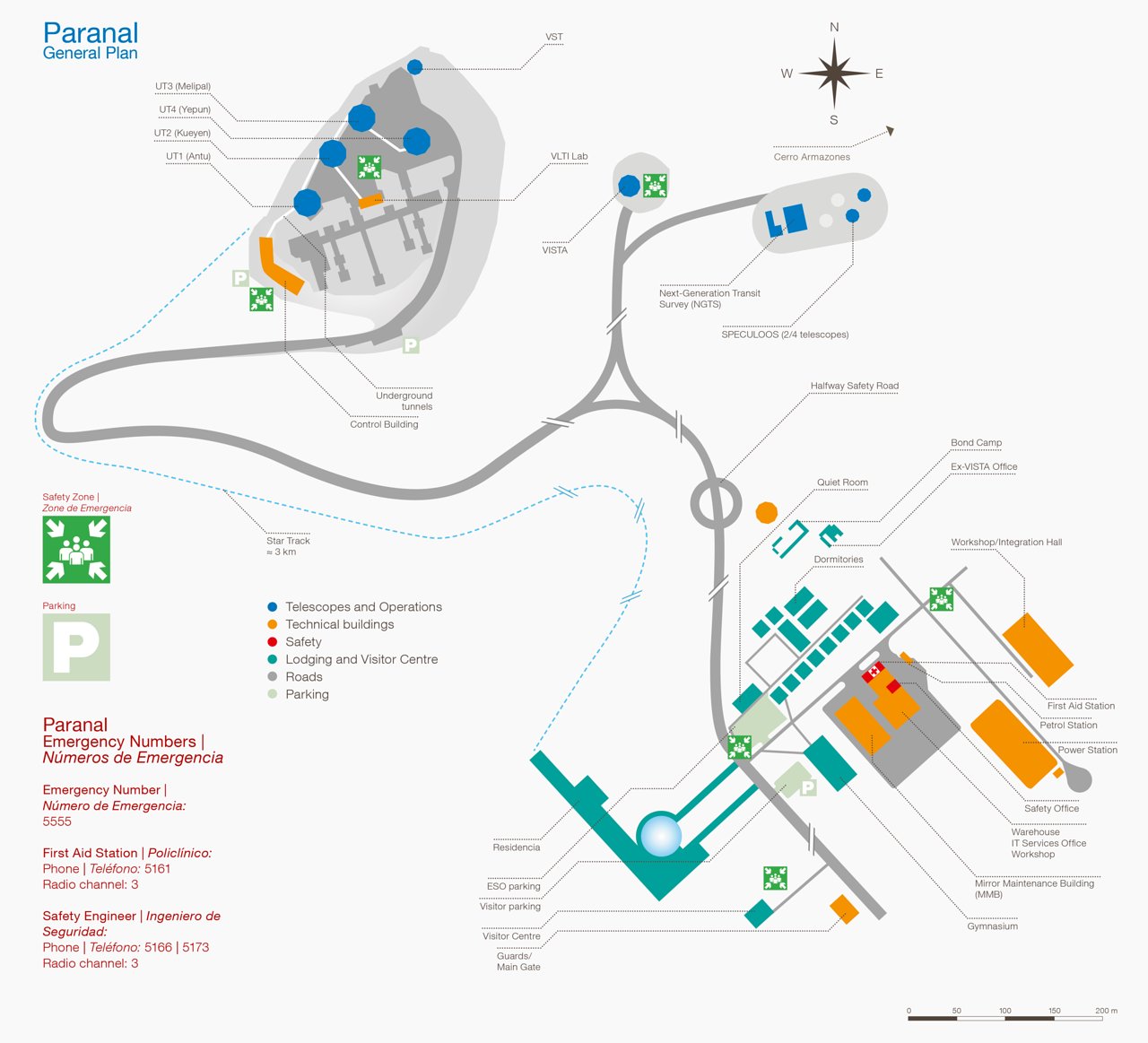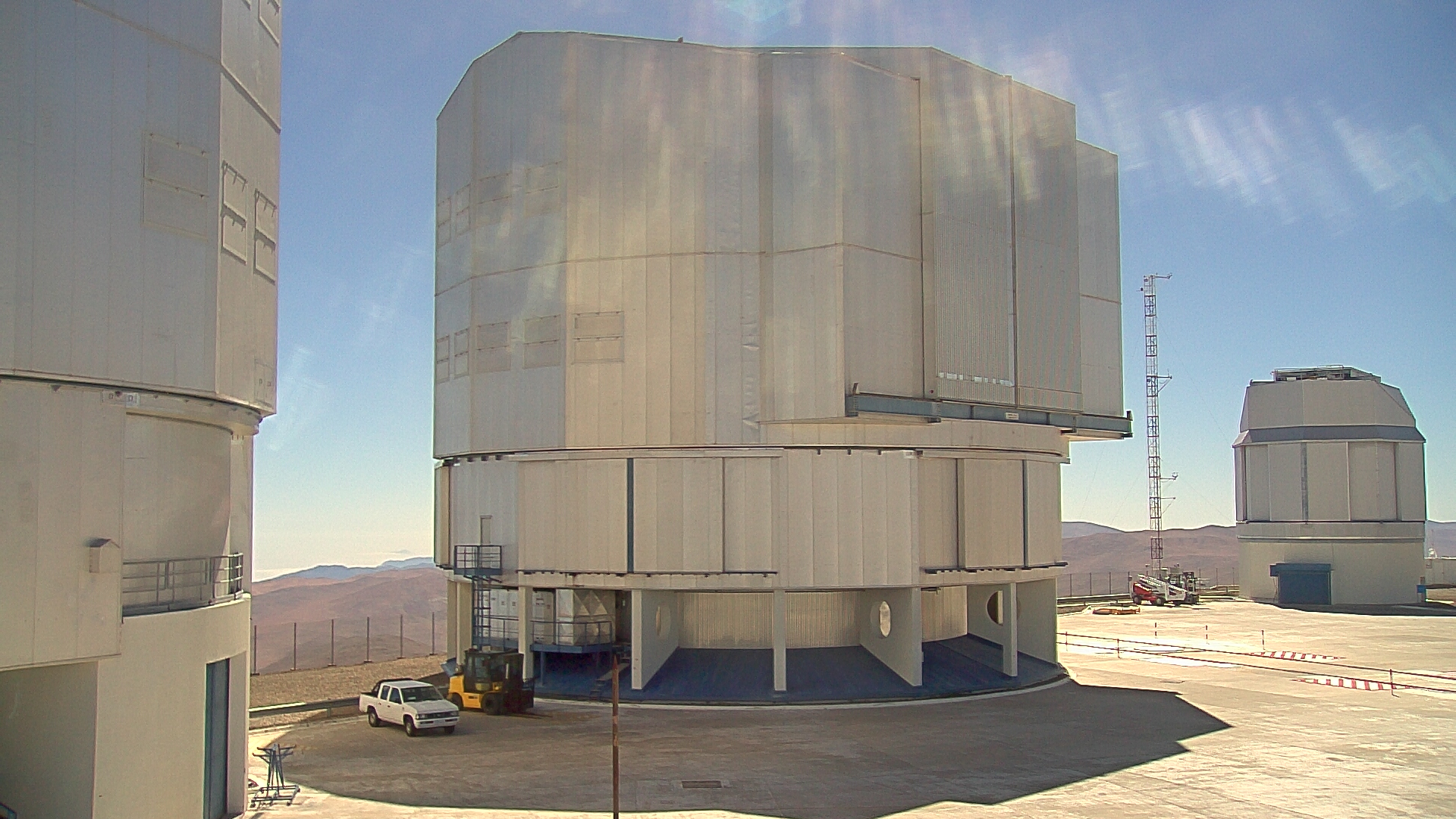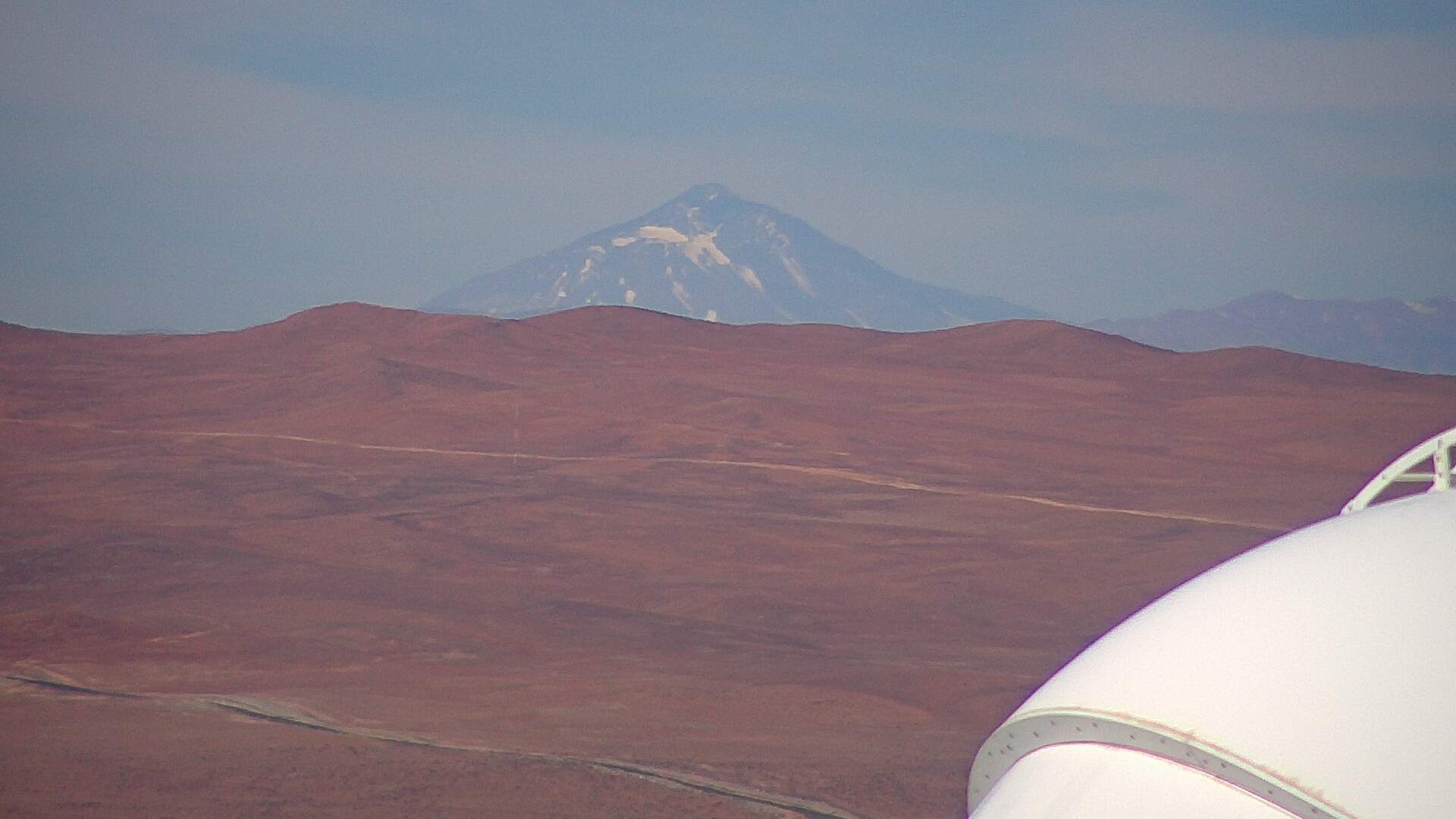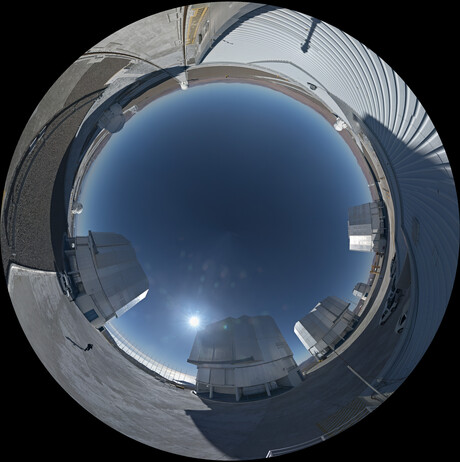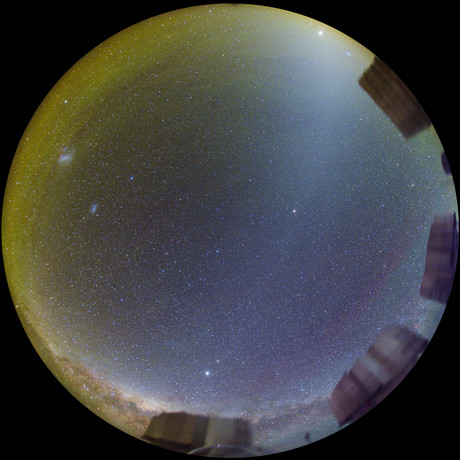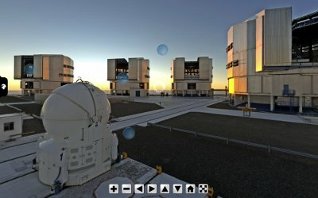Das Very Large Telescope
Das fortschrittlichste optische Observatorium der Welt
LIVE-Panorama vom Paranal ()
Das Very Large Telescope (VLT) ist das Vorzeige-Observatorium der europäischen bodengebundenen Astronomie zu Beginn des dritten Jahrtausends und das höchstentwickelte optische Instrument der Welt. Es besteht aus vier Hauptteleskopen (engl. Unit Telescopes, kurz UTs) mit je 8,2 Metern Spiegeldurchmesser und vier beweglichen 1,8m-Hilfsteleskopen (engl. Auxiliary Telescopes, kurz ATs). Die Einzelteleskope können zu einem gigantischen Interferometer zusammengeschaltet werden, dem VLT-Interferometer (VLTI). Mit dem VLTI lassen sich am Himmel 25 Mal feinere Details auflösen als mit jedem einzelnen der Hauptteleskope. Dazu muss das Licht der Teleskope allerdings über ein komplexes unterirdisches Spiegelsystem so zusammengeführt werden, dass sich die Weglängen der einzelnen Lichtanteile über 100 Meter um nicht mehr als einen Tausendstel Millimeter unterscheiden. Doch die Präzision lohnt sich: mit dem VLTI lassen sich Aufnahmen mit einer Winkelauflösung von Tausendstel Bogensekunden erstellen. Das entspricht der Trennung der zwei Scheinwerfer eines Auto in der Entfernung des Mondes.
Die 8,2-Meter-Hauptteleskope können auch als Einzelteleskope genutzt werden. Jedes davon kann bei einer Belichtungszeit von einer Stunde Bilder von Himmelsobjekten dreißigster Größe aufnehmen – das sind Objekte, die vier Milliarden mal schwächer leuchten als alles, was das menschliche Auge noch ohne Hilfsmittel wahrnehmen kann.
Die Hauptteleskope tragen die Namen Antu, Kueyen, Melipal und Yepun – in der Sprache des Mapuche-Volkes sind das die Bezeichungen für die Sonne, den Mond, das Sternbild Kreuz des Südens und die Venus als Abendstern.
LIVE-Webcam
LIVE-Bild von MELIPAL, auch UT3 genannt ()
An Tagen mit besonders guter Durchsicht ist der großartige, 6739 Meter hohe Vulkan Llullaillaco im Hintergrund dieses Bildes sichtbar. Er liegt unglaubliche 190 Kilometer entfernt an der Grenze zu Argentinien. ()
|
Fischaugenansicht
|
Länger belichtete Fischaugenansicht des Sternhimmels. Nur nachts verfügbar.
|
Das Paranal-Observatorium virtuell besichtigen
|
Klicken Sie auf das Bild um eine Virtuelle Tour zum und durch das VLT zu unternehmen. |
Das Paranal-Observatorium besuchen
- Informationen zu Besuchen von Journalisten, sonstige Medienvertretern und Produzenten
- Informationen zu Wochenendbesuchen von Touristen, Schülern, Studenten und der allgemeinen Öffentlichkeit
Teleskope und Beobachtungsinstrumente
Die am Very Large Telescope eingesetzten Instrumente bilden zusammen eine der umfangreichsten Ausstattungen, die je für ein einziges Observatorien erstellt wurde. Am VLT kommen elektronische Kameras mit großem Gesichtsfeld ebenso zum Einsatz wie Kameras und Spektrografen, bei denen atmosphärische Störungen (das Funkeln der Sterne) durch die Technik der Adaptiven Optik ausgeglichen wird, oder Spektrografen mit hoher Auflösung und solche, die gleichzeitig das Spektrum mehrerer Objekte aufnehmen können. Die vorhandenen Instrumente decken dabei einen breiten Bereich des elektromagnetischen Spektrums ab, der von Ultraviolettlicht (ab einer Wellenlänge von 300 Nanometern) bis in den mittleren Infrarotbereich (bis zu einer Wellenlänge von 24 µm) reicht.
Die Hauptteleskope
Die 8,2-Meter-Hauptteleskope sind in kompakten, temperaturgeregelten Gebäuden untergebracht, die zusammen mit dem Teleskop mitgedreht werden. Die Gebäude sind so ausgelegt, dass Störeffekte, zum Beispiel durch Luftverwirbelungen über den Teleskopspiegeln, wie sie durch Temperaturunterschiede zwischen der Teleskopanlage einerseits und der Nachtluft andererseits entstehen, vermieden werden.
Das erste der Hauptteleskope, "Antu", nahm am 1. April 1999 den wissenschaftlichen Beobachtungsbetrieb auf. Heute sind alle vier Hauptteleskope und Hilfsteleskope im Betrieb.
Die Kuppeln der VLT-Hauptteleskope:
- Höhe: 2850 cm
- Durchmesser: 2900 cm
Die Hilfsteleskope
Die vier 8,2-Meter-Hauptteleskope sind zwar als Teil des VLT-Interferometers einsetzbar, werden aber in der Regel als Einzelteleskope genutzt und stehen daher nur für eine begrenzte Anzahl von Nächten für interferometrische Beobachtungen zur Verfügung. Dank vier kleinerer Hilfsteleskope mit 1,8 Metern Durchmesser, die speziell für den Interferometerbetrieb vorgesehen sind, kann das VLTI trotzdem jede Nacht genutzt werden.
Weitere Informationen erhalten Sie unter diesem Link.
Wissenschaft mit dem Very Large Telescope
 Für die Astronomie hat das VLT eine herausragende Bedeutung. In Zahlen ist das VLT mit im Schnitt pro Tag mehr als einer Fachveröffentlichung (gezählt werden nur Zeitschriften mit Peer-Review) das wissenschaftlich produktivste bodengebundene Observatorium. Es hat außerdem eine neue Ära spannender Entdeckungen eingeläutet. Dazu zählen die erste Aufnahme eines Exoplaneten (eso0428), die Bestimmung der Bahndaten für die Sterne, die um das supermassereiche Schwarze Loch im Zentrum der Milchstraße kreisen (eso0846), und Beobachtungen des Nachleuchtens des entferntesten bislang bekannten Gammastrahlen-Ausbruchs.
Für die Astronomie hat das VLT eine herausragende Bedeutung. In Zahlen ist das VLT mit im Schnitt pro Tag mehr als einer Fachveröffentlichung (gezählt werden nur Zeitschriften mit Peer-Review) das wissenschaftlich produktivste bodengebundene Observatorium. Es hat außerdem eine neue Ära spannender Entdeckungen eingeläutet. Dazu zählen die erste Aufnahme eines Exoplaneten (eso0428), die Bestimmung der Bahndaten für die Sterne, die um das supermassereiche Schwarze Loch im Zentrum der Milchstraße kreisen (eso0846), und Beobachtungen des Nachleuchtens des entferntesten bislang bekannten Gammastrahlen-Ausbruchs.
Wissenschaftliche Ziele
Vielseitiges Großteleskop für das sichtbare Licht und das nahe Infrarot. Anwendungen beinhalten die Erforschung von hochrotverschobenen Galaxien, Sternentstehung, Exoplaneten und protoplanetaren Scheiben.
Weitere Informationen zur Wissenschaft mit dem VLT
- Wissenschaft mit ESO-Teleskopen
- Die Top 10 der astronomischen Entdeckungen der ESO, auf VLT-Daten basieren Nr. 1, 3, 5, 6, 7, und 8 (auch als Präsentation verfügbar)
Weitere Informationen zum Very Large Telescope
- Zahlen und Fakten finden Sie bei den häufig gestellten Fragen
- Weitere Bilder und Videos sind im Multimediaarchiv der ESO abrufbar
- Für Wissenschaftler: Weitergehende Informationen finden Sie auf den technischen Seiten
Die Residencia
Das Gästehaus des Paranal-Observatoriums, die Residencia, ist ein preisgekröntes Gebäude. Dort fanden einige der Dreharbeiten für den James-Bond-Film "Ein Quantum Trost" statt.
VLT-Trailer
Laden Sie den VLT-Trailer aus dem Videoarchiv herunter.
VLT
|
Das VLT bei Google Maps
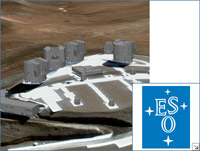
Laden Sie die 3D-Modelle der Teleskope herunter und betrachten Sie sie in Google Earth (kmz, 4,8 MB)
